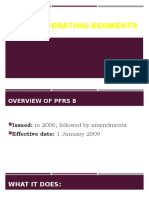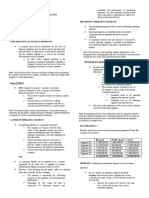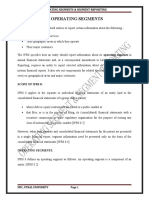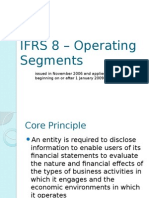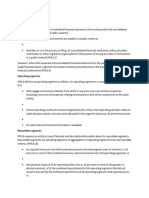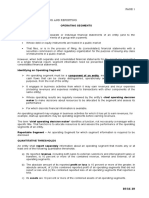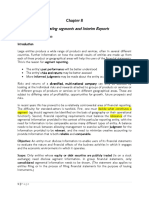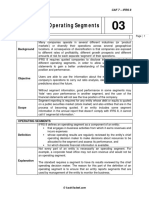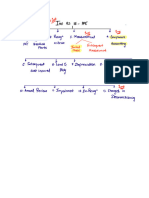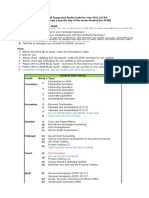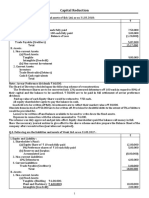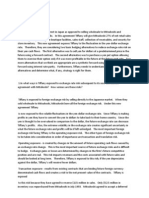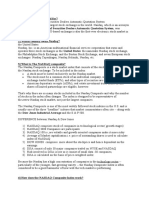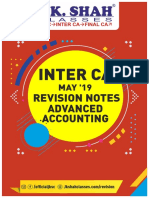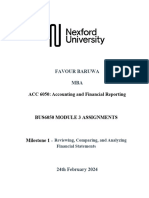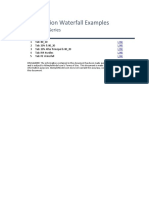110.
309 Advanced Financial Accounting
Segmental Reporting
and
Related parties
1
Learning objectives
Segment Reporting (NZ IFRS 8):
1 1. Define ‘Operating Segment’ (OS).
2. Explain when OS’s are deemed reportable.
3. Outline key disclosures for OS’s.
Related Parties (NZ IAS 24):
2
1. Define ‘Related Party’ (RP) transactions.
2. Explain risks & opportunities of RP transactions.
3. Outline key disclosures for RP’s.
1
� Both topics relate to Disclosure
Importance of Disclosure will be
illustrated by:
General Example disclosures in
selected F/S’s
Introduction The Warehouse 2022 Annual
Report.
Introduction to NZ IFRS 8
• Standard issued as part of convergence project between IASB and FASB
• Relies on a ‘management approach’ to identify segments for reporting
• More principles-based than rules-based.
• Applies to Annual and Interim F/S’s of co’s with publicly traded
securities
2
� What is Segment
Reporting?
The breaking down of accounts of a
conglomerate to provide more info
about its component parts:
• Operating segments
• Products & services
• Geographical areas
• Major customers
Over-riding principle
“An entity shall disclose information to enable users of its financial
statements to evaluate the nature and financial effects of business activities
in which it engages and economic environments in which it operates.”
[NZ IFRS 8 para. 1]
Note the focus on decision-usefulness rather than accountability.
3
� Why is Segment Reporting required?
Consolidated F/S’s provide aggregated results so may lose important info e.g.
• Entities which may be involved in many different activities and/or locations
• Diversification and expansion
• Information about relative size and profitability
NB: segments are not necessarily independent businesses
Why is Segment Reporting required?
Example:
Divisional Data Published Financial
Fast food Waste disposal Statements
Assets $ 1,000,000 $ 1,000,000 $ 2,000,000
Equity 500,000 500,000 1,000,000
Profit 195,000 5,000 200,000
Revenues (sales) 2,000,000 1,500,000 3,500,000
Rate of Return:
On Assets 19.5% .5% 10%
On equity 39.0% 1.0% 20%
On sales 9.75% .33% 5.7% 8
4
� Segmental Reporting
Disadvantages (Costs)
Advantages • Cost v Benefit
• Highlights performance of various • Competitive harm as strategic
parts of group information exposed
• result - improved managerial • May encourage new entrants into the
performance/ accountability industry
• Risk of takeover bids if losses where other
• Improves usefulness of F/S’s for users parties consider they can manage segment
to assess: better
• Future profitability • Management likely to be more
conservative
• Risk (product, geographic)
• Might draw attention from regulators,
• Opportunities for growth trade unions etc.
• Questionable reliability
It is a component of an entity:
• that engages in business activities from
which it may earn revenues and incur
expenses (incl. from inter-entity
transactions);
How are
Operating • whose operating results are regularly
reviewed by the chief operating decision
Segments maker (CODM) for resource allocation
decisions and performance assessment,
defined? and
• for which separate financial information is
available
[NZ IFRS 8 para 5]
10
10
5
� Identifying Operating Segments
11
More on Operating Segments
• Based on segments per internal reports that are regularly reviewed by
CODM in order to allocate resources to segment/assess its performance
.
• Generally, segments have managers who are held responsible for
segment performance.
• NZ IFRS 8 requires that segments identified for internal mgmnt purposes
should be the segments used for external reporting purposes (rather
than providing specific criteria to identify segments) .
12
12
6
� More on Operating Segments
• The following would be operating segments:
• A component of an entity that sells mainly to other operating segments
of that entity;
• A start-up operation which is not yet earning revenues but is expected to.
Corporate headquarters or some functional departments may not earn
revenues, therefore would not be operating segments [NZ IFRS 8, para 6]
13
13
Determining a Reportable Segment
Separate reporting is required if:
• Identified as an operating segment or an
aggregation* of operating segments, and
• Exceeds quantitative thresholds of 10% (next
slide)
* = Aggregation only allowed if segments have similar
economic characteristics i.e. :
o Products/services and production processes
o Customers and distribution methods
o Regulatory environment
14
14
7
� A segment is determined as a
‘reportable segment’ if:
• Its reported revenues (incl. Sales to
external customers + inter-segment Sales or
transfers) ≥ 10% of combined Revenue; or
Quantitative • Absolute amount of its reported Profit or
Loss ≥ 10% of the greater of, in absolute
Thresholds amount, (combined profit of all operating
segments that earned a profit) or
(combined loss of all operating segments
that earned a loss); or
• Its assets ≥ 10% of combined assets of all
operating segments
[NZ IFRS 8 para 13]
15
15
Additional Reporting Requirements
• If total external revenue of reported operating segments < 75% of the
entity’s revenue, additional operating segment(s) need to be identified as
reportable segment(s) [para 15]
(Note: This applies to revenue only not to profits or assets).
• Remaining segments are combined and reported in an ‘all other
segments’ category
• sources of revenue for this category must be described
• Significant Current Year v Prior Year changes
• Include even if below thresholds (restate Prior Year figures where necessary)
16
16
8
�17
Worked Example
• Determination of reportable segments
– worked example 22.1 pg 880
(Remember ‘substantial portion’ test:
OS’s must total ≥ 75% External Rev)
18
18
9
� Worked Example 22.1—Determination of reportable segments
Consider the following segment information in relation to Maldives Ltd. For internal
purposes, the CODM reviews 4 components of the organisation when making decisions
about resources to be allocated and assessing performance.
Segment revenue Profit or loss Segment assets
Business segment ($000) ($000) ($000)
Mining 500 (55 ) 100
Manufacturing 125 (25 ) 20
Chemicals 100 5 10
Agriculture 800 100 150
Total 1 525 25 280
The total revenue of Maldives Ltd is $1 600 000—that is, there is $75 000 in revenue that
is not allocated to an operating segment.
REQUIRED:
Determine which segments of Maldives Ltd are reportable in accordance with the
guidelines provided in AASB 8.
19
Exercise: D&S Q20 – Ocky Ltd (pg. 893)
Segment Revenue Segment Profit Segment Assets
($000) ($000) ($000)
Mining 700 100 1000
Food 125 20 200
Chemicals 50 (35) 100
Clothing 90 5 90
Total 965 90 1390
Required: Determine which segments are reportable according to the guidelines
provided in NZ IFRS 8.
20
20
10
� Required Disclosures
General Information:
• Factors used to identify operating
segments, incl. basis of organisation
• Types of products/services from which
each reportable segment derives revenue.
21
21
Required Disclosures (cont.)
1. Financial Performance & Position Info.
• Profit or loss
• Total Assets*
• Total Liabilities*
Also, disclosure of further specified amounts required about each
reportable segment (if incl. in measuring segment P/L or *). [Para
23-24]
• Interest revenue required separate from interest expense
unless CODM relies on Net interest revenue to assess
performance of the segment.
(* = if regularly reported to CODM)
22
22
11
� Required Disclosures (cont.)
2. Reconciliation Information
(Totals for segments to corresponding amts in F/S’s )
• Revenues,
• Profit or loss,
• Total assets,
• Total liabilities,
• Other amounts disclosed.
23
23
Measurement & Disclosures
Segment revenue, expense, result, assets and liabilities
not defined (i.e., non-GAAP allowed!)
Same basis required as is used internally for:
• evaluating operating segment performance, and
• deciding how to allocate resources to operating segments.
• i.e., Managers have discretion.
Explanation required of measurement incl. any
differences from corresponding F/S figures
24
24
12
� Entity-wide disclosures
If not already provided, disclosure is required
even for single segment entities of:
• Revenue analysed by products and services
• Revenue and certain non-current assets analysed by
geographical region/country
• Major customers - disclose if any customers account
for ≥ 10% of revenue and total amount for each
25
25
Related
Party
Disclosures
(NZ IAS 24)
26
26
13
� Requires disclosure of:
• RP relationships;
Introduction • Transactions with RP’s;
to NZ IAS 24 • Outstanding RP
balances/commitments
27
27
RP’s – Why/how a problem?
Why?
• Corporate governance
• Wealth expropriation
• Companies Act 1993 provisions
• RP’s can manipulate and/or affect financial performance/
position
How?
• Influence and non-arms-length transactions
28
28
14
� Corporate governance
The principal-agent problem
• Investors appoint directors and managers to run the business
• Agents may use their position to enrich selves at owners’
expense
Corporate governance [OECD definition]
• a set of relationships between a company’s management, its
board, its shareholders and other stakeholders….
• the structure through which objectives of co. are set and means
of attaining objectives/monitoring performance determined….
• provide proper incentives for board and mgmnt to pursue
objectives that are in interests of co. and shholders, and
• should facilitate effective monitoring
29
Sell overpriced goods and services
(incl. managerial services) to the firm
Buy assets from the firm at below fair
value
How to Issue new shares of the firm at below
fair value (diluting existing equity)
expropriate
shareholders’ Repurchase shares of the firm at above
fair value
wealth
Borrow from the firm, then default on
the loan
Trade shares on inside information
30
15
� Selected Co’s Act 1993 provisions
• Major asset purchases/ sales require special resolution of shareholders (s. 129)
• Directors must disclose their interest in transaction to the Board and record these
in an “interests register” (s. 140)
• Shares must be issued at a price fair and reasonable to the co. and to all existing
shareholders (s. 47)
• Shares may be repurchased only at a price fair and reasonable to remaining
shareholders; prior disclosure to shareholders is required (s. 61)
• Board can approve pmts/ loans to dirs, but each dir must certify transaction is fair
to the co. (s. 161)
• Dirs buying or selling shares while in possession of inside information can trade
only at fair value (s. 149)
31
Related Party news articles
• ANZ
• Bridgecorp; Dominion Finance; Five Star Finance
32
32
16
� Related Party Relationships
a) Persons and their close family members that control,
joint control, have significant influence over the entity, or
are key management personnel.
b) Entities within a group (parent, subsidiaries)
c) Entities subject to significant influence (assoc., JV., post-
employment benefit plans)*
d) Entities significantly influenced by those identified in (a)
above*
* = Control, joint control or significant influence again present
33
33
Related-party Transactions
Definition:
Transfer of resources, services or obligations between a reporting entity
and a related party, regardless of whether a price is charged.
Transactions between parties are normally at “arm’s-
length”, but if parties are related:
• They may materially affect commercial activities and hence financial
performance and position;
• They may expose the entity to risks or provide opportunities or
restrictions which would otherwise not have existed;
• One company may influence another even if no transactions take
place.
34
34
17
� Disclosure Requirements
• Category of RP’s & nature of relationship
• Parent/sub relationship disclosure required even if no transactions.
• Transactions: Types and amounts
• Outstanding balances & commitments incl.
• terms/conditions e.g., security, repayments
• guarantees given/received
• Bad debts: Written off and if Provisions incl. in O/S balances
• Key management personnel compensation: in total and for
specific categories (see para 17) 35
35
• Recap Objectives
• Questions?
36
36
18
� Related
Parties?
(Extracted from Deegan 9e)
37
37
19



